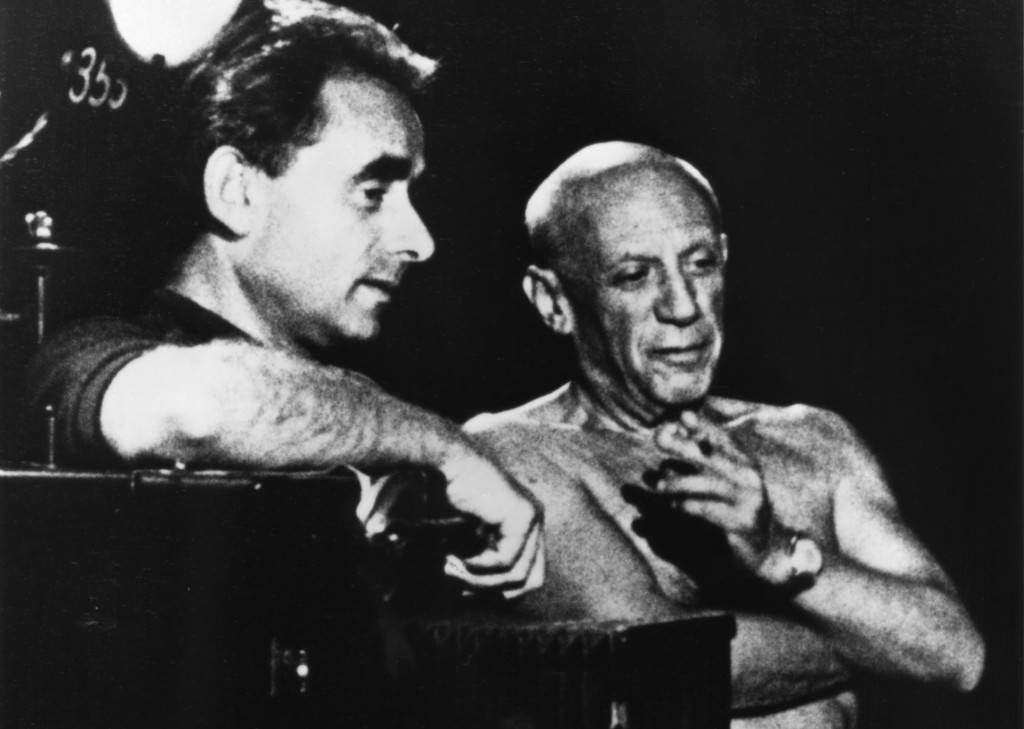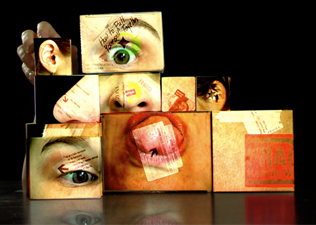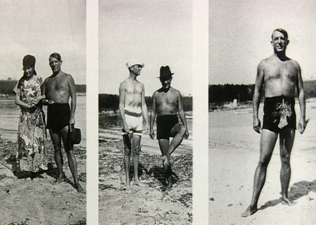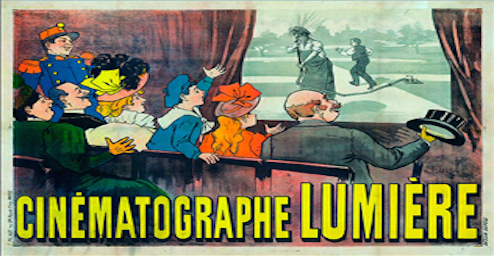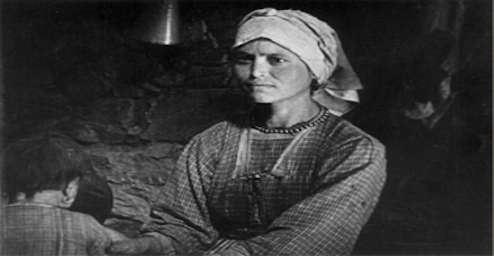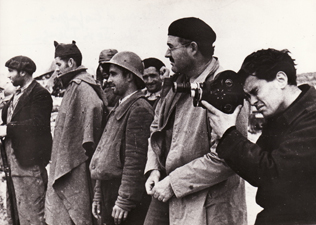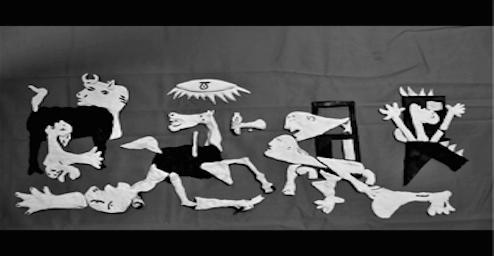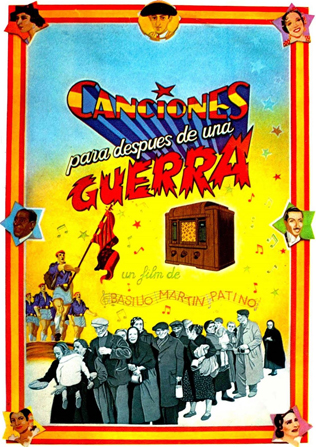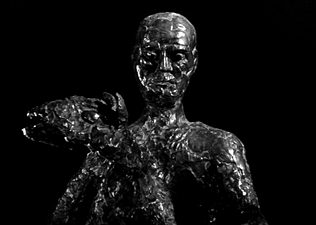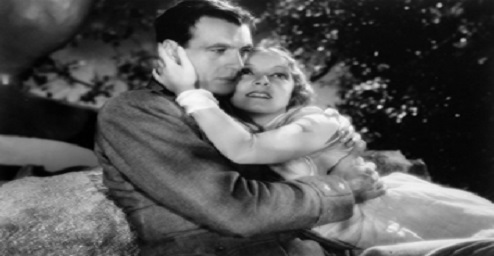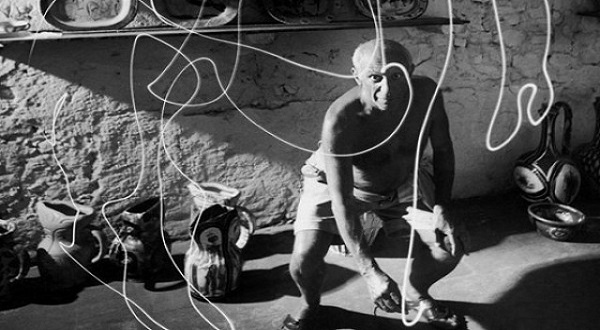
Going Back to Reality
GOING BACK TO REALITY
Venues:
Tate Britain, lnstituto Cervantes,
Barbican and Ciné Lumière (French Institute)
March/April/May/June 2012
London
To complement Picasso’s major exhibition at Tate Britain ‘Picasso and Modern British Art’, Sin Fin Cinema presents GOING BACK TO REALITY Portraying Pablo Picasso on the canvas in motion, a carefully selected body of films, ranging from documentary to experimental, from short film to video art. This programme reveals the lesser known aspects of the Spanish artist’s life and highlights all those essential elements that have been distilled from his works influencing later generations of visual artists, such as the British David Hockey and Henry Moore.
GOING BACK TO REALITY Portraying Pablo Picasso on the canvas in motion refers to a 1981 interview between Melvyn Bragg and David Hockney. In it, Hockney offers a personal account of the development of modern art in the 20th century, and defends its frequent divergence from ‘photographic’ realism; he traces the beginning of the modern movement back to Van Gogh and Cezanne, and to the new interest in stylised Japanese art, which did not concentrate on verisimilitude. In that sense, Hockney maintains that the truly radical development was Cubism. This new technique of depicting reality, which Picasso and Braque developed in the summer of 1917, with its shifting points of view, selective focusing and reliance on knowledge of the subject, marked a breakdown in conventional representation. Using Picasso and Matisse as examples, he demonstrates the ability of modern styles to convey emotions and experiences more vividly than others. According to Hockney, Cubism was the only kind of painting faithful to reality after the advent of photography.
With this film season we are providing a unique opportunity to find out more about Picasso’s life and working process: his youth spent years living in Barcelona and Paris, the friends who surrounded him and the artists that inspired him.
It is undeniable that Guernica and its symbolism, which the artist never wanted to reveal, still continues to raise questions, speculations and investigations. Focusing on one of Picasso’s masterpieces, GOING BACK TO REALITY discloses some of the enigmas surrounding one of the world’s best known paintings. Further, with a special section devoted to British artists, this film season will also discover how cubism would find its way into the work of some of Britain’s major artists such as Duncan Grant, David Hockney and Ben Nicholson.
How Picasso became one of the most celebrated painters in the world and how he became viewed as a genius, are a few of the many questions that this film season will answer.
Virginia Pablos
Director & Founder
GOING BACK TO REALITY Portraying Pablo Picasso on the canvas in motion launches on 2 March 2012 at Tate Britain, as part of the its celebrated eventLate Tate. After, the programme will spread over April, May and June, with Barbican, Instituto Cervantes and the French Institute hosting the screenings and especial events.
PROGRAMME
The Mystery of Picasso
Dir. Henri-Georges Clouzot.
Cast: Pablo Picasso, Claude Renoir, Henri-Georges Clouzot.
France l 1956 l 78 min l Documentary Film
With this film, Henri-Georges Clouzot gave viewers the chance to see the techniques of the most influential painters of the twentieth century, Pablo Picasso. Filmed in the painter’s studio, this unmissable documentary shows us, stroke by stroke, the birth of a masterpiece: We see Picasso in the act of creating paintings for the camera which he then subsequently destroyed, so that they would only exist on film. In this unique film, the whole process of creating a work of art is shown, from the beginnings with Picasso’s simple marker drawings in black and white, until he is gradually progressing to full scale collages and oil paintings. It won the Special Jury Prize at the 1956 Cannes Film Festival.
Visiting Dora
Dir. Ellen Wetmore
USA l 2010 l 2min l Video Art Film
“Visiting Dora Maar” began as a study of Picasso’s portrait of Dora Maar he painted when they were lovers. Visually considered in the lens of the canonical art history portrait, Picasso created a portrait where her features seem to fracture, move about in space and time and become undone. Ellen Wetmore managed to capture the master’s stroke and, using video images of herself, transformed “Visiting Dora Maar” into a moving image meditation about identity and self-assembly, “falling apart” and “pulling oneself together”.
This screening will be followed by a panel discussion
Thu 5th April l 6.30pm l £10, Concessions £8 l Ciné Lumière
Book online
Picasso: Magic Sex Death
Dir. Waldermar Januszczak
UK l 2001 l 151 mins l Documentary Film
In an effort to understand the legendary artist’s inspiration, the film examines Picasso’s life as well as his obsessions with the occult, with eroticism, and with mortality. Written and narrated by Picasso’s friend and biographer, John Richardson, this three part film biography is a fascinating insight into the unknown life of Picasso, his fears and his fascinations.
Fri 2th March l 7pm l FREE SCREENING l Tate Britain. Duffield Room. Late Tate
Picasso & Braque go to the movies
Dir. Arne Glimcher.
Cast: Martin Scorsese, Tom Gunning, Kim Tomadjoglou, Jennifer Wild, Adam Gopnik, John Richardson, Bernice Rose, Natasha Staller, John Yau, Chuck Close, Eric Fischl, Lucas Samaras, Julian Schnabel, Coosje Van Bruggen, and Robert Whitman
USA l 2008 l 62 mins l Documentary Film
A documentary that looks at how early filmmaking influenced the Cubist painters Pablo Picasso and Georges Braque. Produced by Martin Scorsese and Robert Greenhut, Picasso and Braque go to the movies is a cinematic tour through the effects of the technological revolution, specifically the invention of aviation, the creation of cinema and their interdependent influence on artists Pablo Picasso and Georges Braque. With narration by Scorsese, and interviews with art scholars and artists including Chuck Close, Julian Schnabel and Eric Fischl, the film looks at the collision between film and art at the turn of the 20th Century, and helps us to realise cinema’s continuing influence on the art of our time.
Preceded by the video art film
CUBISM
Dir. Robert Gordon
UK l 2009 l 2:30 mins l Video Art Film
A short film inspired by the likes of Picasso, Braque and Duchamp. With talent and creativity, Robert Gordon managed to capture the visual essence and techniques of Cubism and transform them into a beautiful work of moving image.
This screening will be followed by a panel discussion with John Wyver and Kevin Jackson.
24th June l 2.30pm l £9.50, Concessions £8.50 l Barbican
Book online
THE SPANISH CIVIL WAR – PART 1
Land without Bread
Dir. Luis Buñuel Spain l 1933-36 l 32 mins l Documentary Film
Cast: Abel Jacquin and Alexandre O’Neill
Portraying the isolated region of Las Hurdes, an inhospitable Spanish landscape inhabited by people without hope, Land without Bread serves to heighten the devastating imagery of human misery.
Premiered at the Press Palace in Madrid in 1933, the film was immediately banned by the Spanish Republican Government because of its “negativism”. It was later learned that Buñuel used editing tricks to dramatise several sequences and shots in order to rework the traditional documentary style.This Buñuel’s personal “essay in human geography”, is an astonishing documentary that never leaves few people indifferent.
Followed by a panel discussion with Joanna Evans, Sarah Wright and Manuel Ramos.
Fri 4th May l 6.30pm l FREE SCREENING l Instituto Cervantes.
Highly recommended to book in advanced, please contact: reservas.londres@cervantes.es
The Spanish Earth
Dir. Joris Ivens. Cast: Manuel Azaña, José Díaz and Dolores Ibárruri
USA l 1937 l 52 min l Documentary Film
Considered one of the greatest war films ever, The Spanish Earth was produced with funds raised by a group of American intellectuals and Hollywood members who wanted to support the Spanish Republic, including poet Archibald McLeash, writer Lillian Hellman, Ernest Hemingway, and composer Virgil Thomson.
The film portraits the defence of Madrid and how its inhabitants try to survive and produce food for their soldiers. Stunningly shot, often in dangerous battle areas where the Spanish Civil War was taking place, The Spanish Earth can be considered one of the most significant and timely documents of our time.
After the war, Franco’s government declared Joris Ivens ̈a persona non grata ̈ and banned him from entering the country.The filmmaker returned to Spain for the first time after the prohibition in 1985, when the Madrid’s Cinémathèque paid a deserved tribute to him.
Preceded by the short film
Guernica
Dir. Alexis Peña, Adrián Sevillano, Miguel Ángel Fernández and Pablo Piñeiro
Spain l 2009 l 1:47 min l Short Film
A fresh interpretation of Picasso’s Guernica.
Followed by a panel discussion with Paul Prestón, Joanna Evans and Peter Anderson.
Fri 11th May l 6.30pm l FREE SCREENING l Instituto Cervantes.
Highly recommended to book in advanced, please contact: reservas.londres@cervantes.es
Canciones para después de una guerra
Dir: Basilio Martín Patino Cast: Imperio Argentina, Estrellita Castro and Miguel de Molina
Spain l 1971 l 115 mins l Documentary Film
Made clandestinely using found footage and sound recordings from the Spanish Post-war period, the film couldn’t be released until after the dictator General Franco had died.
The film documents popular songs in the period immediately after the Spanish Civil War ended in 1939, but when re-editing the images, Patino managed to dislocate them from their original purpose and intention, revealing new readings, meanings and questions. Canciones para después de una guerra consists of a collage of signs rescued from oblivion; Songs of patriotic exaltation, religious devotion and victorious voices. Unusual and daring, dissenting with respect to any regulations, academic or aesthetic cannons, this masterpiece sent shockwaves throughout Spanish society, regardless of age and political leanings.
This screening will be followed by a panel discussion with Joanna Evans, Sarah Wright and Peter Anderson.
Fri 18th May l 6.30pm l FREE SCREENING l Instituto Cervantes.
Highly recommended to book in advanced, please contact: reservas.londres@cervantes.es
THE SPANISH CIVIL WAR – PART 2
On April 26 1937, the small Basque town of Guernica was bombed without warning by the German aviation. Like millions all over the world, Pablo Picasso remained shocked by the military atrocities and translated his emotions and anger into a magnificent but terrifying canvas bearing the name of the martyred city.
The Guernica painting was commissioned by the Spanish Republican government to be displayed inside the Spanish Pavilion at the 1937 World’s Fair Paris Exhibition, alongside two of the most significant works depicting and denouncing the horrors of the Spanish Civil War; Joan Miró’s The Reaper and Alexander Calder’s Mercury Fountain.
In a time when the Spanish Civil War was destroying Spain and the World War II was knocking on Europe’s doors , the international impact of the canvas, with a dimension of 349,3×776.6 centimetres, was absolutely enormous.
Even today, this masterpiece continues to be embedded in the retina of our time
Guernica
Dir. Alain Resnais & Robert Hessens
Screenplay: Paul Éluard (poem) Cast: María Casares, Jacques Pruvost
France l 1950 l 13 mins l Short Film l Special 16mm print
After a brief voiceover by Jacques Pruvost highlighting the Guernica massacre, María Casares recites a poem by Paul Éluard on the subject, whilst oppressive musical arrangements and shots over the Guernica painting are accompanied with her voice. Alain Resnais and Robert Hessens revisited Picasso’s work in order to return to that precise period in history; The atrocities of the Spanish Civil War and its tragic consequences.
Fri 2th March l 8.45pm l FREE SCREENING l Tate Britain. Auditorium. Late Tate
A Farewell to Arms Dir: Frank Borzage
Dir: Frank Borzage
Cast: Gary Cooper, Helen Hayes and Adolphe Menjou
USA l 1932 l 80 minutes l Feature Film
Based upon an Ernest Hemingway’s semi-autobiographical novel published in 1929, A Farewell to Arms is a tale of love, focused on the tragic romance between an ambulance driver, Lt. Henry, and a nurse during the World War I.This anti-war drama, set in Italy, shows one of the most thrilling visions of the power of love during war times. No other director created images like these, using light and movement like brushstrokes, integrating naturalism and daring expressionism in all his shots.
Premiered in Paris in 1933, this romantic melodrama has a sequence of less than 5 minutes, (showing a night exodus of military and civilian population on a road whilst being bombed), which according to José Luis Alcaine, , keeps striking parallelism with the main characters in Picasso’s painting, frame by frame.
Followed by a panel discussion with José Luis Alcaine

